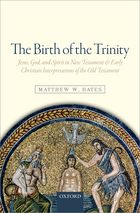 This is the second in a two-part interview with Matthew Bates on his recent book The Birth of the Trinity (find the first part HERE)
This is the second in a two-part interview with Matthew Bates on his recent book The Birth of the Trinity (find the first part HERE)
Matt Lynch [ML]: Three things stood out to me: (1) You’ve excavated a Trinitarian reading strategy that shows enormous continuity between the NT and early Patristic eras. (2) The idea that this reading strategy goes back to Jesus himself, and in texts that many scholars attribute to the historical Jesus! (3) I loved the reading of Heb 10:6-7, and your description of the Son ‘regifting’ his body back to the Father. As you state, ‘The Father initiates the gracious gift-giving with the presentation of the incarnational body to the Son, yet the Son consummates the gift-giving by offering this very same body back to the father …’ (p.87). This puts the atoning sacrifice of Jesus on a more relational (rather than transactional) footing.
Could you give an example of prosopological exegesis of an Old Testament text?
ML: That’s a very personal insight into Trinitarian conversations … as if we’re dealing with … well … persons! If we grant Jesus’ conception of his own pre-existence, as you suggest in the book, how do you move from Jesus’ pre-existence to ontological parity with the Father and Spirit? In other words, how can we say that these theodramatic conversations reveal the birth of the Trinity, and not just belief in the pre-existence of Jesus, a divine being?
ML: Again, you’ve turned the interview around. This is against protocol! OK, I’m just going to control my temper here and answer. … I think this is where the Trinitarian approaches help each other, and in particular, models 3 & 4 mentioned above. Where I find Hurtado & Co. helpful is in understanding how Yhwh devotion was received by Jesus, and with Bauckham & Co. how Jesus does Yhwh stuff. Both of these insights suggest that early followers saw ontological parity between Jesus and Yhwh. In my mind this complements your insights into the pre-existent Jesus and intra-Trinitarian dialogue.
Your book helps give depth to our understanding of the Trinity. The Father, Son, and Spirit were seen to be in rich dialogue with one another. Do you think we can read other Old Testament texts theodramatically?
ML: I’m not yet settled on this, at least on whether we have sufficient warrant to read any texts in such a way that they provide a previously unseen window into intra-Trinitarian dialogues. Nonetheless, your controls on reading theodramatically (ch. 7) are helpful.
What are the implications of your work for systematic theology?
MB: Well, I’ll be curious to see what the systematicians make of The Birth of the Trinity. I do believe that my results mesh well with the traditional Nicaean-Constantinopolitan conclusion that God is three persons subsisting in one divine essence, although my work emphasizes the “persons” category. I wonder if those favoring social models of the Trinity—that is, those who prioritize persons in relationship over one divine essence—will see my book as offering support? I also wonder if those who emphasize the economic Trinity or the Trinity-as-revealed-in-history will find my work useful for opening up some new scriptural vistas.
Thanks, Matt L., for your excellent questions. It’s always great to talk with you, whether in person or via the keyboard—and it has been a delight chatting with you about the book. A final remark: Research-writing is always arduous, but the time I spent penning The Birth of the Trinity was often an exciting and (dare I say) worshipful experience. What pleases me most is that a number of readers and reviewers have remarked that the book has enhanced their love for the triune God. May God be praised: Father, Son, and Spirit.
ML: Thanks Matt. Always a pleasure.


